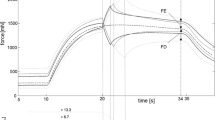Summary
Strips of urinary bladder smooth muscle were subjected to a series of quick release measurements. Each measurement consisted of several releases and resets to the original length, made during one contraction. The complete length-force characteristic of series elasticity was quantified by estimatingH, the amplitude of quick release necessary to reduce the active force to exactly zero, andD b, a measure for the deviation of the characteristic from a straight line. By measuring a series of contractions at increasing stretched strip lengths, the length dependence of these parameters was studied. It was found thatH depends linearly on stretched strip length. On averageH/length amounted to 0.04.D b decreased when strips were stretched, i.e. a straight line was more closely approximated. Both parameter dependencies support the concept of two separate elastic mechanisms, a linear true passive elasticity in series with a non-linear elasticity in the cross-bridges. For the latter,H amounts to 3.8% of the initial strip length.
Similar content being viewed by others
References
Bagby, R. M. &Corey-Kreyling, M. D. (1984) Structural aspects of the contractile machinery of smooth muscle: ‘Is the organization of contractile elements compatible with a sliding filament mechanism?’ InSmooth Muscle Contraction. (Edited byStephens, N. L.) pp. 47–74. New York: Marcel Dekker.
Bressler, B. H. &Clinch, N. F. (1974) The compliance of contracting skeletal muscle.J. Physiol (Lond.) 237, 477–93.
Fay, F. S., Fogarty, K. &Fujiwara, K. (1984) The organization of the contractile apparatus in single isolated smooth muscle cells. InSmooth Muscle Contraction. (edited byStephens, N. L.) pp. 75–90. New York: Marcel Dekker.
Ford, L. E., Huxley, A. F. &Simmons, R. M. (1977) Tension responses to sudden length change in stimulated frog muscle fibres near slack length.J. Physiol. (Lond). 269, 441–515.
Gabella, G (1981) Structure of smooth muscles. InSmooth Muscle: An Assessment of Current Knowledge (edited byBulbring, E. et al.) pp. 1–46. London: Edward Arnold.
Griffiths, D. J., Van Mastrigt, R., Van Duyl, W. A. &Coolsaet, B. L. R. A (1979) Active mechanical properties of the smooth muscle of the urinary bladder.Med. Biol. Eng. Comp. 17, 281–90.
Hellstrand, P. &Johansson, B. (1979) Analysis of the length response to a force step in smooth muscle from rabbit urinary bladder.Acta Physiol. Scand. 106, 221–38.
Hellstrand, P. (1979) Mechanical and metabolic properties related to contraction in smooth muscle.Acta Physiol. Scand Suppl. 464.
Huxley, A. F. (1957) Muscle structure and theories of contraction.Progr. Biophys.Chem. 7, 255–318.
Huxley, A. F. (1974) Review Lecture: Muscular Contraction.J. Physiol (Lond). 243-1, 1–43.
Krebs, H. A. (1932) Untersuchungen uber die harnstoffbildung in Tierkorper.Hoppe Seyler's Zeit. Physiol. Chemie 210, 33–67.
Meiss, R. A. (1978) Dynamic stiffness of rabbit mesotubarium smooth muscle: Effect of isometric length.Am. J. Physiol 234-1, C14-C26.
Mulvany, M. J. (1984) Cross-bridges in smooth muscle. InSmooth Muscle Contraction, (edited byStephens, N. L.) pp. 145–50. New York: Marcel Dekker.
Murphy, R. A. (1976) Contractile system function in mammalian smooth muscle.Blood Vessels 13, 1–23.
Van Mastrigt, R. (1977) Constant-step approximation of multi-exponential signals using a least squares criterion.Comp. Biol. Med. 7, 231–47.
Van Mastrigt, R. &Tauecchio, E. A. (1982) Serieselastic properties of strips of smooth muscle from pig urinary bladder.Med. Biol. Eng. Comp. 20, 585–94.
Van Mastrigt, R. &Glerum, J. J. (1985) Electrical stimulation of smooth muscle strips from the urinary bladder of the pig.J. Biomed. Eng. 7, 2–8.
Van Mastrigt, R., Koopal, J. W. B., Hak, J. &Van De Wetering, J. (1986) Modeling the contractility of urinary smooth muscle using isometric contractions.Am. J. Physiol. 251, R978-R983.
Meiss, R. A. (1978) Dynamic stiffness of rabbit mesotubarium smooth muscle: effect of isometric length.Am. J. Physiol. 234-1, C14-C26.
Warshaw, D. M. &Fay, F. (1984) Tension transients in single isolate smooth muscle cells: insight into the cross-bridge mechanism. InSmooth Muscle Contractions (edited byStephens, N. L.) pp. 131–44. New York: Marcel Dekker.
Author information
Authors and Affiliations
Rights and permissions
About this article
Cite this article
Van Mastrigt, R. The length dependence of the series elasticity of pig bladder smooth muscle. J Muscle Res Cell Motil 9, 525–532 (1988). https://doi.org/10.1007/BF01738757
Received:
Issue Date:
DOI: https://doi.org/10.1007/BF01738757




